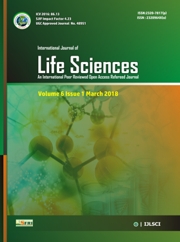RESEARCH ARTICLES
Volume 6 |Issue 6| Nov-Dec 2018 First published: 31 December 2018
Histochemical Study of Protein in Interstitial Cells in the Ovaries of bats Rousettus Leschenaulti, Megaderma Lyra Lyra, Hipposideros Speoris
Meshram Nitin P and Janbandhu KS
1Department of Zoology, S K Porwal College, Kamptee.(M.S). [INDIA]
2Govt. Institute of Science College, Nagpur.(M.S). [INDIA]
*Corresponding author Email: nitinmesh2015@gmail.com
Abstract
Keywords:Protein , Mercury Bromophenol blue , Interstitial Cells, Ovary
Editor: Dr.Arvind Chavhan
Cite this article as:
Meshram Nitin P and Janbandhu KS. Histochemical Study of Protein in Interstitial Cells in the Ovaries of bats Rousettus Leschenaulti, Megaderma Lyra Lyra, Hipposideros Speoris. Int. Res. Journal of Science & Engineering, 2018, 6 (6): 255-264.
References
1. Guraya SS. Interstitial gland tissue of mammalian ovary. Acta Endocrinol (suppl.), 1973; 171: 5-27.
2. Kanako M. Heterogeneity of ovarian Theca and interstitial gland cellsinmice. 2015ploSONE10(6):0128352.http//doi.org/10.1371/Journal.pone.0128352.
3. Gopalakrishna A and Sapkal BM Breeding biology of some Indian bats- A review J. Bombay nat. Hist. Soc. 1986; 83 : 78-101.
4. Sastry MS and Pillai SB Variations in the epithelial cords of the ovaries of a microchiropteran bat, Hipposideros speoris (Schneider) during reproductive cycle: An enzymic approach. Journal of Cell and Animal Biology, 2013; Vol. 7(11): 132-137.
5. Simmons NB. Order Chiroptera. In Wilson, DE and Reeder, DM (eds.) Mammal Species of the World, Third Edition. The Johns Hopkins University Press, 2005; Baltimore,: 312-529.
6. Wimsatt WA. Glycogen, polysaccharides complexes and alkaline phosphatase in the ovary of the bat during hibernation and pregnancy. Anat. Rec, 1979; 103:564-565.
7. Chapman DM. Dichloromatism of bromophenol blue, with an improvement in the mercuric bromophenol blue technic for protein. Stain technology, 1975; 50:25-30.
8. Mossman HW and Koering. MJ Cyclic changes of interstitial gland tissue of the human ovary.American Journal of Anotomy, 1964; Vol. 115, issue 2, pages 235-255.
9. Sastry MS and Tembhare D. Some Histochemical observations on the ovarian stromal interstitial cell during anoestrous and oestrous in Indian leaf-nosed but Hipposideros speoris (Schneider). The Bioscan, 2008; 3(2): 139-146.
10. Chanda D, Yonekura M. and Krishna A. Pattern of ovarian protein synthesis and secretion during the reproductive cycle of Scotophilus healthi; synthesis of the albumin like protein, Informa healthcare- Biotechnic and Histochemistry. 2004; Vol. 79, No. 3-4, Pages 129-138.
11. Krishna A. High androgen production by ovarian thecal interstitial cells: a mechanism for delayed ovulation in the tropical vespertilionid bat, Scotophilus heathi. J. Reprod. Ferti., 1996; 106: 207-211.
12. Braden AWH. Properties of the membranes of rat and rabbit eggs. Aust. J. Sci. Res., . 1952; 5: 460-471.
13. Hillard J, Archibald D and Sawyer CH. Gonadotropic activation of the preovulatory synthesis and release of progestin in the rabbit. Endocrinology, 1963; 72: 59-66.
14. Keyes PL and Nalbandov AV. Endocrine function of the ovarian interstitial gland of rabbits. Endocrinology, 1968; 82: 799-804.
15. Modak SP and Kamat DN A study of periodic acid schiff material in ovarian follicles of trophical bats. Cytologia, 1968; 33(1): 54-59.
16. Clark J. and Book F. Effect of gonadotrophins on the ovarian interstitial tissue of the wood mouse, Apodemus sylvaticus. Reproduction, 2001; 121: 123-129.
17. Erickson GF, Magoffins DA, Dyer CA, Nofeditz C. The ovarian androgen producing cells: a review of structure/ function relationship. Endocrine Rev, 1985; 6: 371-399.
18. McManus JFA. The histochemical demonstration of mucin after periodic acid. Nature, 1946; 158:202.
19. Silavin SL, Greenwald GS In-vitro progesteron production by ovarian interstitial cells from hypopysectomized hamsters. J. Reprod. Fertil., 1982; 66: 291-298.

